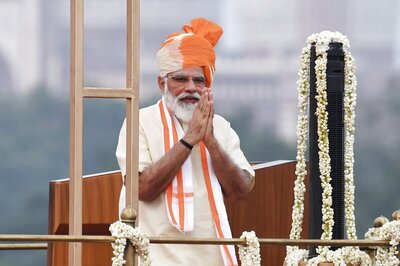
views
For weeks now, a conservation debate has been bubbling around cutting of over 2,000 trees for a Metro project in Mumbai’s Aarey Colony, as every person with an opinion has been weighing in from across the country. More than a thousand kilometres away, another man vs wild controversy has received far less attention.
However, statements last week by Rahul Gandhi, Member of Parliament from Kerala’s Wayanad constituency, have placed the spotlight back on the controversial night-time traffic ban on national highway (NH) 766, which cuts across the Bandipur Tiger Reserve (BTR) in neighbouring Karnataka and Wayanad Wildlife Sanctuary. After meeting his constituents, Gandhi said that he stands in solidarity with the youth who have been on a hunger strike, protesting against the travel restrictions on the highway, which connects Kozhikode district in Kerala with Kollegal in Karnataka.
He went on to say, “I am confident a compromising solution can be reached where the people of Wayanad benefit and the environment is also protected. This has been achieved in other parts of the country, and I am sure it can be achieved here as well.”
Residents of Wayanad, especially the town of Sultan Bathery, have been protesting a proposed progression of the night-time traffic ban, which has been in effect for the last ten years, to a complete stoppage of traffic on the 19-km stretch of the NH 766 that runs through the tiger reserve just across the border.
On August 8, the Supreme Court not only upheld the night-time traffic ban that lasts from 9pm to 6am, but also asked the concerned parties to look for alternate routes to avoid the protected area (PA) altogether. It was this decision by the SC that sparked unceasing protests in Wayanad, where residents fear they will be completely cut off, in the worst-case scenario, or at the minimum suffer economically as well as lose access to essential services if this stretch of the highway is closed permanently.
As KG Sudheesh, a member of the youth movement, says, “In Wayanad, you have to understand that apart from NH 766, all other roads are Ghat roads or mountainous roads and become dangerous during the rainy season. This road is the backbone of Wayanad and, if it is closed, we will have no access to essential medical services, since there are no other means of transportation from this region to the rest of the country.”
He adds, “We are planning to challenge the Supreme Court’s decision with an intervening petition. If we receive an unfavourable verdict again, the people of Wayanad will be escalating the protests and completely shutting off this road until our issues are addressed.” The protesters have already taken part in multiple hunger strikes and are now demanding not only the revocation of the night-time traffic ban but also construction of an elevated corridor across the affected section of the Bandipur Tiger Reserve.
‘Death knell for the forests’
Conservationists and environmentalists, both in Kerala and Karnataka, say that an elevated corridor or removal of the night-time traffic ban would sound the death knell for the wildlife and biodiversity in the region. MD Madhusudan, a Bengaluru-based researcher and former member of the National Wildlife Board (NWB), says, “For me what is at stake here is the larger principle based on which protected areas (PA) are designated. The idea behind creating a PA, according to the National Wildlife Plan, issued by the environment ministry, is to harmonise these areas with other aspects such as growth and development. We have decided that there are some areas in our country that are repositories of a natural heritage that we don’t want to lose. To keep them as they are, we have decided that priorities that affect other non-protected regions such as infrastructure for growth, etc, need not be prioritised here as well. It is a system of avoidance to preserve these areas.”
There are 668 protected areas in India that cover over 1.61 lakh kilometre of the country’s geographical area, or roughly five per cent of India’s landmass. “So if you decide to cut down forests even within these protected areas for an elevated corridor and state that somehow this already minimum landmass is a hindrance to development and progress, it then goes against the spirit of why you have protected areas at all in the first place,” Madhusudan adds. “You have to understand that even if this five per cent of landmass is completely destroyed for development, there will still be challenges. The elevated corridor will not solve your problems.”
N Badusha, president of the Wayanad Prakruthi Samrakshana Samithi, an environmental organisation based in the region, concurs, “It is not only that they want elevated corridors, but they will be building steel walls right through the forest as well, apart from widening the road. This will be an extremely harmful project.”
He adds, “I believe most people in Wayanad are not supporting the protests and I say this as a long-time resident of the region. In fact, the recent spate of natural disasters have only made people in Kerala more sensitive to the consequences of environmental degradation. I think most of these protests are being backed by vested interests such as politicians, merchants and those in the tourism sector who will be affected if the road is closed.”
The Bandipur Tiger Reserve along with Nagarhole, Mudumalai, Sathyamangalam and Wayanad is the source population in the Western Ghat landscape complex with an estimated tiger population of 382. This constitutes the single largest (one- eighth) wild population of tigers in the world. The park is an important component of the 5,520 sq km Nilgiri Biosphere Reserve, the first of its kind in the country, and is also home to the largest population of Asiatic elephants in the world.
The government of Kerala and the ministry of road transport and highways are keen on removing night-time restrictions as well as constructing elevated corridors on NH 766 that runs through the reserve. On the other hand, the government of Karnataka, National Tiger Conservation Authority (NTCA) as well as environmentalists are opposed to this.
(Author is an independent environmental journalist based in Bengaluru. He tweets @sibi123.)



















Comments
0 comment